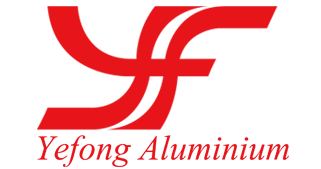
Aluminium knowledge
Aluminum alloys (or aluminum alloys; see spelling differences) are alloys in which aluminum (Al) is the predominant metal. The typical alloying elements are copper, magnesium, manganese, silicon, tin and zinc. There are two principal classifications, namely casting alloys and wrought alloys, both of which are further subdivided into the categories heat- treatable and non-heat-treatable. have been very important in aerospace manufacturing since the introduction of metal-skinned aircraft. Aluminum-magnesium alloys are both lighter than other aluminum alloys and much less flammable than other alloys that contain a very high percentage of magnesium
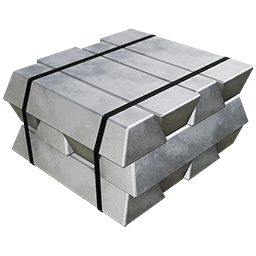
WROUGHT ALLOYS
The International Alloy Designation System is the most widely accepted naming scheme for wrought alloys. Each alloy is given a four-digit number, where the first digit indicates the major alloying elements, the second — if different from 0— indicates a variation of the alloy, and the third and fourth digits identify the specific alloy in the series. For example ,in alloy 3105, the number 3 indicates the alloy is in the manganese series, 1 indicates the first modification of alloy 3005, and finally 05 identifies it in the 3000 series
TEMPER DESIGNATION
The temper designation follows the cast or wrought designation number with a dash, a letter, and potentially a one to three digit number, e.g. 6061-T6. The definitions for the tempers are:
- F : As fabricated
- H : Strain hardened (cold worked) with or without thermal treatment
- H1 : Strain hardened without thermal treatment
- H2 : Strain hardened and partially annealed
- H3 : Strain hardened and stabilized by low temperature heating
Second digit : A second digit denotes the degree of hardness
- HX2 = 1/4 hard
- HX4 = 1/2 hard
- HX6 = 3/4 hard
- HX8 = full hard
- HX9 = extra hard
- O : Full soft (annealed)
- T : Heat treated to produce stable tempers
- T1 : Cooled from hot working and naturally aged (at room temperature)
- T2 : Cooled from hot working, cold-worked, and naturally aged
- T3 : Solution heat treated and cold worked
- T4 : Solution heat treated and naturally aged
- T5 : Cooled from hot working and artificially aged (at elevated temperature)
- T51 : Stress relieved by stretching
- T510 : No further straightening after stretching
- T511 : Minor straightening after stretching
- T52 : Stress relieved by thermal treatment
- T6 : Solution heat treated and artificially aged
- T7 : Solution heat treated and stabilized
- T8 : Solution heat treated, cold worked, and artificially aged
- T9 : Solution heat treated, artificially aged, and cold worked
- T10 : Cooled from hot working, cold-worked, and artificially aged
- W : Solution heat treated only
ALLOY DESIGNATIONS
- 1000 series are essentially pure aluminium with a minimum 99% aluminium content by weight and can be work
hardened. - 2000 series are alloyed with copper, can be precipitation hardened to strengths comparable to steel. Formerly
referred to as duralumin, they were once the most common aerospace alloys, but were susceptible to stress corrosion
cracking and are increasingly replaced by 7000 series in new designs. - 3000 series are alloyed with manganese, and can be work hardened.
- 4000 series are alloyed with silicon. Variations of aluminium-silicon alloys intended for casting (and therefore not
included in 4000 series) are also known as silumin. - 5000 series are alloyed with magnesium, and offer superb corrosion resistance, making them suitable for marine
applications. Also, 5083 alloy has the highest strength of not heat-treated alloys. Most 5000 series alloys include
manganese as well. - 6000 series are alloyed with magnesium and silicon. They are easy to machine, are weldable, and can be
precipitation hardened, but not to the high strengths that 2000 and 7000 can reach. 6061 alloy is one of the most
commonly used general-purpose aluminium alloys. - 7000 series are alloyed with zinc, and can be precipitation hardened to the highest strengths of any aluminium alloy
(ultimate tensile strength up to 700 MPa for the 7068 alloy). Most 7000 series alloys include magnesium and copper
as well. - 8000 series are alloyed with other elements which are not covered by other series. Aluminium-lithium alloys are an
example.
APPLICATIONS
Aerospace alloys
The following aluminum alloys are commonly used in aircraft and other aerospace structures
- 1420
- 2004; 2014; 2017; 2020; 2024; 2080; 2090; 2091; 2095; 2219; 2224; 2324; 2519; 2524
- 4047
- 6013; 6061; 6063; 6113; 6951;
- 7010; 7049; 7050; 7055; 7068; 7075; 7079; 7093; 7150; 7178; 7475;
- 8009;
The following list of aluminum alloys are currently produced, but less widely used
- 2090 aluminium
- 2124 aluminium
- 2324 aluminium
- 6013 aluminium
- 7050 aluminium
- 7055 aluminium
- 7150 aluminium
- 7475 aluminium
Second digit : A second digit denotes the degree of hardness
- HX2 = 1/4 hard
- HX4 = 1/2 hard
- HX6 = 3/4 hard
- HX8 = full hard
- HX9 = extra hard
- O : Full soft (annealed)
- T : Heat treated to produce stable tempers
- T1 : Cooled from hot working and naturally aged (at room temperature)
- T2 : Cooled from hot working, cold-worked, and naturally aged
- T3 : Solution heat treated and cold worked
- T4 : Solution heat treated and naturally aged
- T5 : Cooled from hot working and artificially aged (at elevated temperature)
- T51 : Stress relieved by stretching
- T510 : No further straightening after stretching
- T511 : Minor straightening after stretching
- T52 : Stress relieved by thermal treatment
- T6 : Solution heat treated and artificially aged
- T7 : Solution heat treated and stabilized
- T8 : Solution heat treated, cold worked, and artificially aged
- T9 : Solution heat treated, artificially aged, and cold worked
- T10 : Cooled from hot working, cold-worked, and artificially aged
- W : Solution heat treated only
Marine alloys
These alloys are used for boat building and shipbuilding, and other marine and salt-water sensitive shore applications
- 5052 aluminium alloy
- 5059 aluminium alloy
- 5083 aluminium alloy
- 5086 aluminium alloy
- 6061 aluminium alloy
- 6063 aluminium alloy
Automotive alloys
6111 aluminum and 2008 aluminum alloy are extensively used for external automotive body panels, with 5083 and 5754 used for inner body panels. Bonnets have been manufactured from 2036, 6016, and 6111 alloys. Truck and trailer body panels have used 5456 aluminum. Automobile frames often use 5182 aluminum or 5754 aluminum formed sheets, 6061 or 6063 extrusions.Wheels have been cast from A356.0 aluminum or formed 5xxx sheet. Cylinder blocks and crankcases are often cast made of aluminum alloys. The most popular aluminum alloys used for cylinder blocks are A356, 319 and to a minor extend 242.
Note: Above information are extracted from Wikipedia®
About Fastener Materials
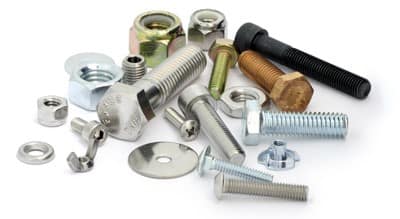
General
Fasteners are manufactured in a wide range of materials from common steel to titanium, plastic and other exotic materials. Many materials are further separated into different grades to describe specific alloy mixtures, hardening processes, etc. In addition, some materials are available with a variety of coatings or platings to enhance the corrosion resistance or alter the appearance of the fastener.
Fastener material can be important when choosing a fastener due to differences between materials in strength, brittleness, corrosion resistance, galvanic corrosion properties and, of course, cost.
When replacing fasteners, it is generally best to match what you are replacing. Replacing a bolt with a stronger one is not always safe. Harder bolts tend to be more brittle and may fail in specific applications. Also some equipment is designed so that the bolts will fail before more expensive or critical items are damaged. In some environments, such as salt water, galvanic corrosion must also be considered if changing fastener materials.
Materials

Aluminum
Aluminum is a light, soft, corrosion resistant metal. Like stainless steel, aluminum’s corrosion resistance is inherent to the material. Therefore, scratches and nicks will not effect the corrosion resistance.
Fasteners are made from a variety of aluminum alloys, with elements such as manganese, silicon, iron, magnesium, zinc, copper, and silicon being added to increase strength and melting point.
Rivets are often made from aluminum alloys in the 5000-series, which uses magnesium as the primary alloying element.
For more information see our Aluminum Hot Rolled Wire Introduction page.

Stainless Steel
Stainless steel is an alloy of low carbon steel and chromium for enhanced corrosion characteristics. Stainless steel is highly corrosion resistant for the price. Because the anti-corrosive properties are inherent to the metal, it will not lose this resistance if scratched during installation or use.
It is a common misconception that stainless steel is stronger than regular steel. In fact, due to their low carbon content, many stainless steel alloys cannot be hardened through heat treatment. Therefore, when compared to regular steel, the stainless alloys used in bolts are slightly stronger than an un-hardened (grade 2) steel but significantly weaker than hardened steel fasteners. Unless great care is taken, stainless fasteners are susceptible to seizing up during installation, a phenomenon known as galling.
Most stainless steel fasteners are much less magnetic than regular steel fasteners though some grades will be slightly magnetic.

Steel
Steel is the most common fastener material. Steel fasteners are available plain as well as with various surface treatments such as zinc plating, galvanization, and chrome plating.
Steel fasteners are commonly available in 4 grades: Grade 2, Grade 5, Grade 8, and Alloy Steel. Many other grades exist but are used far less often. Grade 2, 5, and 8 are usually plated with a slightly blue-ish or yellow zinc coating, or are galvanized, to resist corrosion.
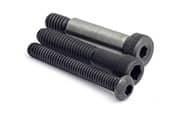
Alloy Steel
Alloy steel bolts are made from a high strength steel alloy and are further heat treated. Alloy steel bolts are typically not plated, resulting in a dull black finish. Alloy steel bolts are extremely strong but very brittle.
Silicon Bronze
Silicon bronze, often referred to simply as bronze, is an alloy made mostly of copper and tin with a small amount of silicon. Bronze is used primarily in marine environments. It is preferred over stainless in wooden boat construction and re-fastening due to its superior corrosion resistance, and over brass due to its higher strength. Bronze is similar to copper in color and is also sometimes seen in fine woodworking where it is used for its appearance. The main drawback of bronze is its high cost.
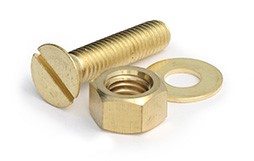
Brass
Brass is an alloy of primarily copper and zinc. Brass is highly corrosion resistant and electrically conductive. However, its use as a fastener is somewhat limited due to its relative softness. It is used primarily for its appearance.
Coatings
Zinc Plating
Many steel fasteners are electroplated with zinc for better corrosion resistance. Fasteners that have been zinc plated have a shiny, silvery or golden appearance, referred to as clear or yellow zinc respectively. They are fairly corrosion resistant but will rust if the coating is destroyed or if exposed to a marine environment.
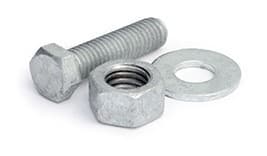
Hot Dip Galvanizing
Galvanizing is another coating involving the application of a layer of zinc. Hot dip galvanizing puts the thickest possible coating on the metal, resulting in superior corrosion resistance. Due to the thickness of the coating hot dipped galvanized bolts are not compatible with other nuts. Galvanized nuts are tapped slightly larger than other nuts to accommodate this coating.
Hot dipped galvanized fasteners are frequently used outdoors, especially in coastal environments.
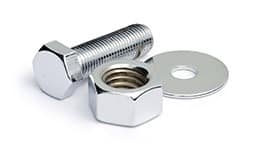
Chrome
Fasteners are chrome plated and polished for appearance. Chrome plating provides similar corrosion resistance to zinc plating. The main drawback of polished chrome is its high cost. If more corrosion resistance is required, stainless steel may be chrome plated, preventing any corrosion should the chrome be penetrated.
Rivets Introduction
A rivet is a mechanical fastener consisting of a smooth, cylindrical shaft with a head. Upon installation, the end of the shaft expands, creating a “shop head” and fastening objects in place. Rivets are ideal for supporting shear and tensile loads, as well as watertight applications.
Semi-Tubular Rivets & Full Tubular Rivets
Semi-tubular rivets are similar to solid rivets but contain a hole at the end of the rivet opposite the head. Semi-tubular rivets also require less force needed for application and assembly.

⦁ Brake Lining Rivet
⦁ Clutch Facing Rivet
⦁ Countersunk Rivet
⦁ Disc Brake Lining Rivet
⦁ Flat Head Rivet
⦁ Oval Head Rivet
⦁ Truss Head Rivet
Solid Rivets
One of the oldest rivets around, the classic solid rivet, it is incredibly strong. It is considered one of most tamper proof and vibration resistant fasteners available.

⦁ Flat / Nail Head Thinners Rivet
⦁ 78° Countersunk Rivet
⦁ 90° Countersunk Rivet
⦁ 100° Countersunk Rivet
⦁ Pan Head Rivet
⦁ Modified Brazier Head Rivet
⦁ Brazier Head Rivet
⦁ Round Head Rivet
⦁ Aluminum Round Head Rivet
⦁ Universal Head Rivet
Blind Rivets
Ideal for projects where access to the joint is limited to only one side. Blind rivets (or “pop” rivets) are available in standard, structural, closed end and various other styles for a wide range of applications.
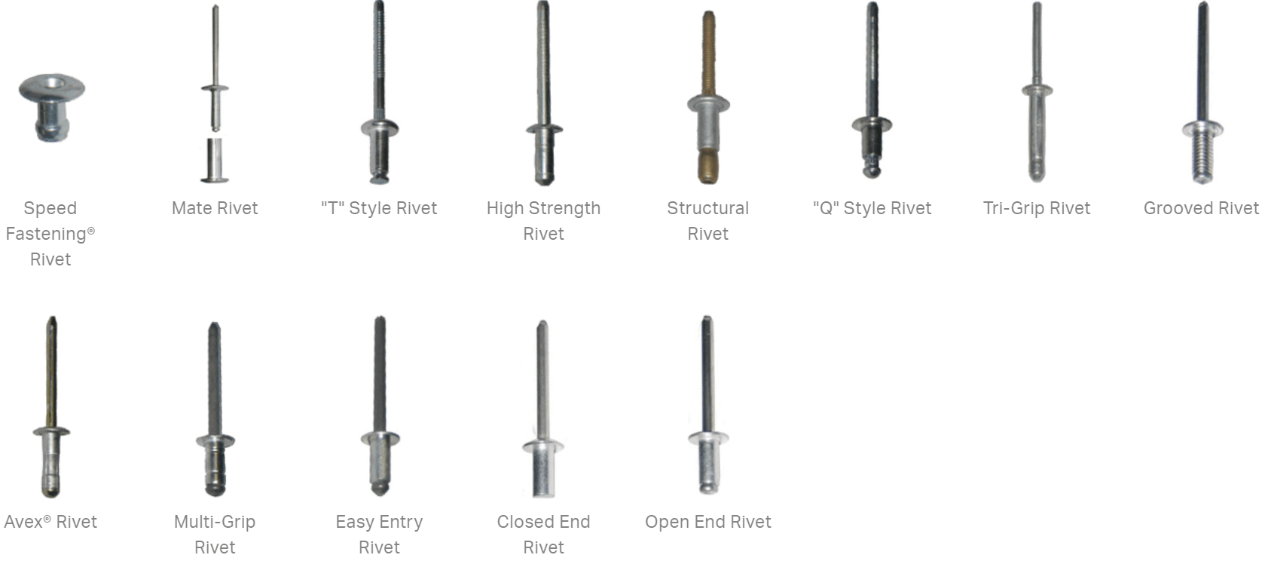
⦁ Speed Fastening® Rivet
⦁ Mate Rivet
⦁ “T” Style Rivet
⦁ High Strength Rivet
⦁ Structural Rivet
⦁ “Q” Style Rivet
⦁ Tri-Grip Rivet
⦁ Grooved Rivet
⦁ Avex® Rivet
⦁ Multi-Grip Rivet
⦁ Easy Entry Rivet
⦁ Closed End Rivet
⦁ Open End Rivet
Threaded Inserts & Rivet Nuts
Threaded inserts and rivet nuts provide a uniquely strong permanent thread through sheet materials and other materials where installation is only possible from one side.

⦁ Pull-Up Stud
⦁ Self-Clinching Hardware
⦁ Self-Clinching Hardware
⦁ Well Nut®
⦁ Jack Nut®
⦁ Closed End Rivet Nut
⦁ Open End Rivet Nut
⦁ Square Sert®
⦁ Full Hex Rivet Nut
⦁ Half Hex Rivet Nut
⦁ Thin Nut
⦁ Flush Nut
Drive Rivets
Drive rivets are installed by driving the center pin into the body of the rivet to cause the other end of the rivet to flare out and fasten materials together.
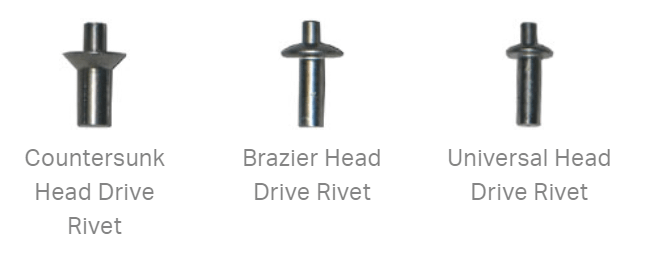
⦁ Countersunk Head Drive Rivet
⦁ Brazier Head Drive Rivet
⦁ Universal Head Drive Rivet
Split Rivets
Split rivets are ideal for piercing through softer materials such as most woods, leather, and plastic.
Special Rivets & Custom Cold Headed Parts

⦁ Clinch Nut
⦁ Stand-Off Clinch Nut
⦁ Staking Stud
⦁ Drive Screw
⦁ Clevis Pin
⦁ Collar Rivet
⦁ Weld Stud
⦁ Shoulder Rivet
⦁ Binder Post & Screw
Nuts

Rivet alloys, shear strengths, and driving condition
Alloy typea
Alphabetical letter
Driven condition
Marking on head
2117
AD
2117T3
DIMPLE
5056
B
5056H32
RAISED CROSS
2017
D
2017T31
RAISED DOT
2024
DD
2024T31
TWO RAISED DASHES
7050
E (or KE per NAS)
7050T73
RAISED RING
Alloy typea | Alphabetical letter | Driven condition | Marking on head |
2117 | AD | 2117T3 | DIMPLE |
5056 | B | 5056H32 | RAISED CROSS |
2017 | D | 2017T31 | RAISED DOT |
2024 | DD | 2024T31 | TWO RAISED DASHES |
7050 | E (or KE per NAS) | 7050T73 | RAISED RING |
ADVANTAGES OF ALUMINUM FOR FASTENERS
Resistance to atmospheric corrosion: Because of its tendency to form a protective oxide coating upon exposure to the atmosphere, aluminum needs no further treatment in ordinary environments. Special alloys and anodic coatings are available for application in extra-corrosive environments.
Economy. Most often aluminum threaded fasteners cost less than those made of brass or stainless steel. Since aluminum fasteners require no maintenance, they will often offset the initial cost advantage of cheaper fasteners.
Nonstaining. The oxides of aluminum are colorless, and such corrosion products as may occur will not mar the finish of products or assemblies.
Strength. Aluminum possesses the best strength-to-weight ratio of any metal in common use. It can be made stronger than mild steel. Aluminum fasteners are strong enough to be used in highspeed, automatic production lines.
Lightness. Aluminum weighs about one-third as much as mild steel. Although weight is not a significant factor in most applications for fasteners, lightness can reduce costs and facilitate movement into, through and out of the manufacturing plant.
Compatibility with aluminum. It is standard practice to fasten aluminum with aluminum in order to minimize the danger of galvanic corrosion. Colorability. Color-anodized fasteners are made for interior applications. Aluminum accepts paint readily. By either process, the range of shades is practically unlimited, making it a simple matter to match any designer’s choice of colors.
Conductivity. Aluminum’s high rate of conductivity suits it for use in many electrical applications.
Nonmagnetic. Aluminum is the preferred metal in applications where magnetism may be a problem. In addition, aluminum’s nonmagnetic properties prevent “clustering” where the fastener is to be handled by tools made of ferrous metals. Variety. Aluminum Fasteners has expanded the number of standard types of sizes of aluminum threaded fasteners to more than 3,700. Special fasteners can be made to meet specific user needs.
Resistance to chemical corrosion. Aluminum is compatible with many chemicals, and may be used safely in containers holding foods, pharmaceuticals and most chemical products.
